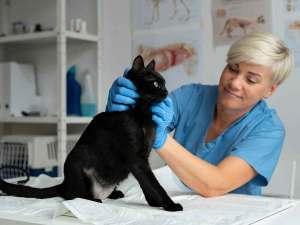Many pet parents fear diabetes is too much to manage, and it may be the end of the road for their furry loved one. But, with insulin therapy, the right diet and exercise your pet can live a happy and normal life.
What’s the 411 on diabetes?
● Diabetes is caused by little to no production of insulin (a hormone produced by certain cells in the pancreas) in the body. Insulin usually keeps your dog or cat’s glucose concentration at a normal level while delivering glucose (energy) to the body’s cells. In diabetic animals, these cells produce little or no insulin, or there is an abnormal response to the insulin that is produced.7
● 1 out of every 100 dogs that reach 12 years of age will develop diabetes.1 In cats, it’s estimated that between 1 in 50 and 1 in 500 will develop diabetes mellitus.2
● In general, diabetes cannot be cured. Some cats have transient diabetes and can go into remission, but it is more likely that a cat will have diabetes for life.
What are the signs of diabetes?
If any of the following signs apply, you should bring your dog or cat to your veterinarian for a checkup.
1. Urinates frequently.4 Your dog or cat wants to go outside or to the litter box often.
2. Drinks a lot of water.4 You must fill the water bowl with more frequency or notice your cat or dog drinking from unusual places, such as the toilet bowl.
3. Is always hungry.4 Your dog or cat never seems to get enough to eat and is always begging for food.
4. Has lost weight.4 Insufficient insulin hinders the body from getting glucose from the blood into the body’s cells for use as energy. When this happens, the body starts to burn fat and muscle for energy and reduces overall body weight.
5. Eyes appear cloudy. This sign is more common in dogs. Excess glucose in the bloodstream causes changes in the lens of the eye. Water enters into the lens, causing swelling and changes in the lens structure. This results in the development of cataracts in the eye.4
6. Lethargy.4 Excess weight and lack of energy can cause your pet to sleep more or be less active.
The above signs may suggest diabetes but are also seen in other diseases. If your pet displays any of these signs, he/she should be taken to the vet immediately, as an animal can only be diagnosed when glucose is found both in the urine and at a high level in the blood through medical samples.
Are certain pets more likely to develop diabetes?
● In dogs, diabetes mellitus is seen in all sexes and ages but is most common in middle-aged to older dogs, especially females.5
● Certain breeds of dogs also experience above-average rates of diabetes. These include toy poodles, terriers, cocker spaniels, dachshunds, Doberman pinschers, German shepherds, Labrador retrievers, and golden retrievers.5
● Most cats that develop diabetes are older than six years of age.7 Certain breeds, such as Burmese, Maine coon, and Birman experience an above-average rate of diabetes.6
● In younger animals, diabetes can be a sign that your cat or dog is genetically predisposed to diabetes, which can mean that related animals may also be predisposed.3
How do I manage my pet’s diabetes?
Monitoring your pet’s glucose level is an important part of the overall therapy for diabetes and can be done in various ways. Talk to your veterinarian about which tests can be administered in office or at home, and which is best for your pet’s condition.
● Measure the glucose level in your pet’s blood.8 This is done either by your veterinarian in the clinic or at home with a portable glucometer and blood test strips.
● Check your pet’s urine for the presence of glucose and ketones (a chemical produced by the body when it burns fat for energy).8
● Monitor levels of fructosamine (a serum protein) in the blood.8
Diet is also key to maintaining your pet’s health
The two key factors in maintaining a healthy diet for diabetic pets are what they’re eating and the timing of their meals. A number of prescription pet foods have been specifically formulated for the management of diabetic dogs and cats. These can be particularly useful for achieving weight loss in obese pets. However, many diabetic dogs and cats can be managed on a carefully controlled program while still eating their regular pet food.
It’s important to consistently follow the recommended feeding schedule for your pet, in order to regulate insulin levels.7 Clean drinking water should be available to your pet at all times. A reduction in excessive water consumption indicates successful management of diabetes mellitus.8
References:
1. Feldman EC, Nelson RW. Canine and Feline Endocrinology and Reproduction. 3rd ed. St. Louis, MO: Saunders; 2004:486–538.
2. Reusch C. Feline diabetes mellitus. In: Ettinger SJ, Feldman EC, eds. Textbook of Veterinary Internal Medicine. 7th ed. St. Louis, MO: Saunders; 2010:1796–1816.
3. Diabetes Mellitus. Washington State University College of Veterinary Medicine. https://hospital.vetmed.wsu.edu/2022/03/17/diabetes-mellitus/
4. Diabetes mellitus in dogs and cats. Merck Veterinary Manual. https://www.merckvetmanual.com/endocrine-system/the-pancreas/diabetes-mellitus-in-dogs-and-cats
5. Feldman EC, Nelson RW. Canine and Feline Endocrinology and Reproduction. 3rd ed. St. Louis, MO: Saunders; 2004:486–5538.
6. Öhlund M, Müllner E, Moazzami A, et al. Differences in metabolic profiles between the Burmese, the Maine Coon and the Birman cat—three breeds with varying risk for diabetes mellitus. PLOS ONE. 2021;16(4).
7. Diabetes in pets. AVMA.org. https://www.avma.org/resources/pet-owners/petcare/diabetes-pets
8. Cook AK. Monitoring methods for dogs and cats with diabetes mellitus. Journal of Diabetes Science and Technology. 2012;6(3):491-495.
Want to share this article?
More like this
September is dog tick season
The weather is beautiful, fall is just around the corner … and it’s peak season for ticks.
Tick talk
Use our tick identifier to select a tick and learn about what it looks like, where it lives, and what risks it might pose to your pet.
Caring for a senior pet
Cats and dogs may need special attention as they age, so it helps to understand what to expect as your pet gets older.





 Go To United States
Go To United States Austria
Austria Belgium
Belgium Czech Republic
Czech Republic Denmark
Denmark Europe
Europe Finland
Finland France
France Germany
Germany Greece
Greece Hungary
Hungary Ireland
Ireland Israel
Israel Italy
Italy Netherlands
Netherlands Norway
Norway Poland
Poland Portugal
Portugal Romania
Romania Spain
Spain Sweden
Sweden Turkey
Turkey United Kingdom
United Kingdom